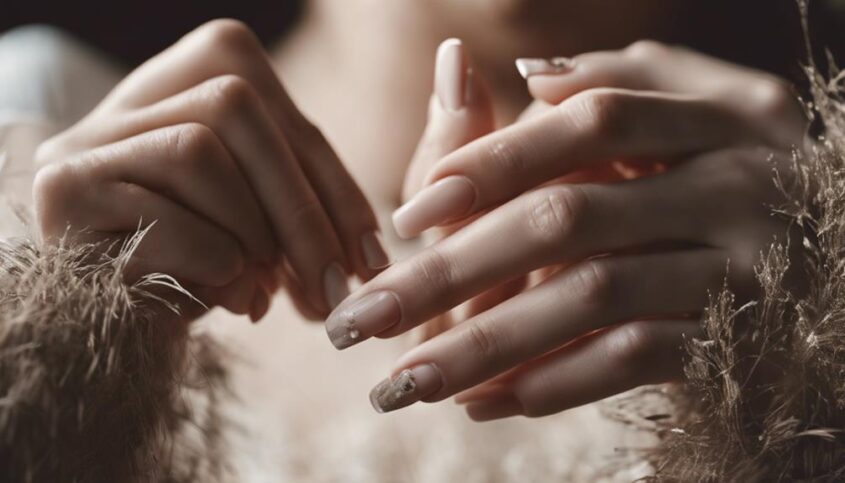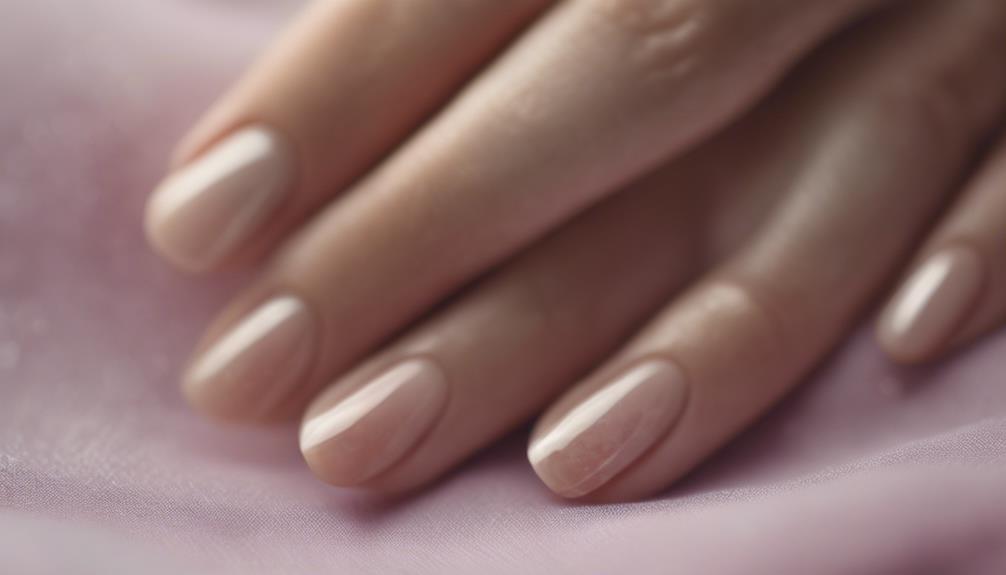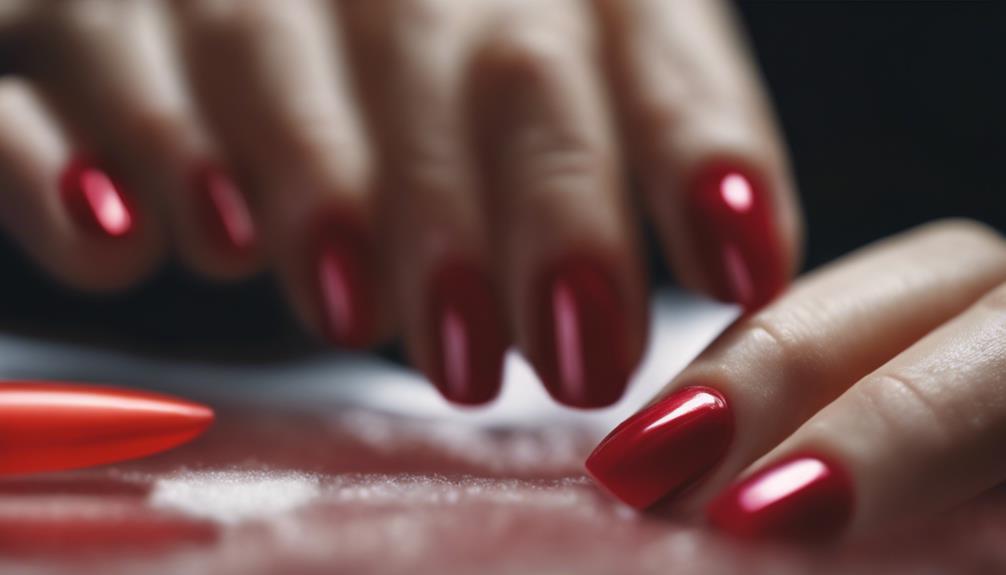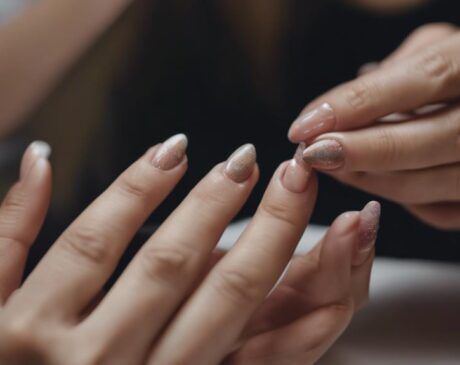Should You Take a Break From Fake Nails?

Taking a break from fake nails is advisable to preserve the health of your natural nails. Fake nails can cause damage, weaken nails, and lead to pain from the weight and pressure of longer nails. Additionally, they can strip essential oils, increasing dryness and brittleness. Being cautious with hygiene is crucial to prevent fungal infections. Consider the long-term effects on your nail bed health and the financial costs associated with maintenance. Transitioning to natural nails can promote strength and thickness, but proper care is essential. Learn more about the impacts and tips for a healthy nail transition.
Key Takeaways
- Yes, breaks allow natural nails to recover from damage.
- Rest prevents weakening, breakage, and thinning.
- Avoiding fake nails reduces risk of fungal infections.
- Breaks promote nail strength and thickness.
- Rest periods prevent allergic reactions and save time and cost.
Potential Damage to Natural Nails

While wearing fake nails can enhance the appearance of one's hands, it is important to consider the potential damage they may cause to natural nails. Constant wear of fake nails can weaken the natural nail bed, making them more prone to breakage and thinning. The adhesives used to apply fake nails can also strip the natural nails of essential oils, leading to dryness and brittleness. Furthermore, the weight and pressure from longer or thicker fake nails can cause stress on the natural nails, potentially resulting in pain or discomfort.
To combat these issues, individuals can benefit from taking breaks between wearing fake nails to allow their natural nails to recover and strengthen. During these breaks, it is advisable to moisturize the nails regularly and maintain a balanced diet rich in vitamins and minerals that promote nail health. Additionally, opting for lighter and more flexible fake nail options can help reduce the risk of damage to the natural nails while still achieving a stylish look. By being mindful of the potential damage fake nails can cause, individuals can make informed decisions to maintain the health and vitality of their natural nails.
Risk of Fungal Infections
When it comes to fake nails, the risk of fungal infections is a crucial aspect to consider. Proper prevention techniques can help safeguard against these unwanted infections. Understanding the importance of nail health and using correct removal methods are key factors in maintaining overall nail well-being.
Fungal Infection Prevention
To minimize the risk of fungal infections, proper hygiene practices and regular maintenance of natural nails are essential when taking a break from fake nails. It is crucial to keep the nails clean and dry to prevent the growth of fungi in the nail bed. Additionally, allowing the nails to breathe and recover from the artificial enhancements can help maintain nail health. Below is a table highlighting key practices for fungal infection prevention:
| Fungal Infection Prevention Tips | Description | Benefits |
|---|---|---|
| Keep nails clean and dry | Regularly wash and dry nails thoroughly | Prevents fungal growth and infection |
| Avoid prolonged moisture exposure | Limit time spent in water and wear gloves | Reduces risk of fungal development |
| Use antifungal treatments | Apply antifungal products as a preventive measure | Helps combat fungal infections if present |
Nail Health Concerns
Maintaining optimal nail health involves understanding the risks associated with fungal infections and implementing preventive measures to safeguard against such concerns. Fungal infections, such as onychomycosis, can occur when moisture gets trapped between the natural nail and artificial enhancements like acrylics or gels. This warm and damp environment provides the perfect breeding ground for fungi to thrive, leading to discolored, thickened, or brittle nails. To prevent fungal infections, it is crucial to keep nails dry, clean, and properly maintained. Additionally, allowing nails to breathe by taking breaks from fake nails can help reduce the risk of fungal growth. Prioritizing nail health through proper care and maintenance is essential for preserving the integrity and aesthetics of your nails.
Proper Removal Techniques
Proper removal techniques are crucial in minimizing the risk of fungal infections associated with the prolonged use of fake nails. When it comes to safeguarding nail health, innovative methods can make all the difference. Opting for acetone-based removers or wraps that contain acetone can effectively dissolve the adhesive used to attach fake nails, facilitating gentle removal. These techniques help prevent damage to the natural nail bed, reducing the likelihood of creating an environment where fungi can thrive. Additionally, incorporating nourishing oils or creams post-removal can aid in restoring moisture and fortifying the nails against potential infections. Prioritizing proper removal practices not only maintains nail health but also promotes overall well-being by mitigating the risk of fungal complications.
Nail Strength and Thickness
Enhancing the durability and thickness of your nails is essential for maintaining healthy nail growth. To achieve strong and thick nails, consider the following innovative tips:
- Hydration is Key: Keep your body hydrated to support nail health from within.
- Balanced Diet: Incorporate foods rich in biotin, zinc, and vitamins to promote nail strength.
- Protective Base Coat: Use a strengthening base coat to shield your nails from damage.
- Regular Trimming: Trim your nails regularly to prevent breakage and promote stronger growth.
Allergic Reactions to Products

To ensure optimal nail health, it is important to be aware of potential allergic reactions that can arise from nail products. While many nail products are safe for use, some individuals may experience allergic reactions to certain ingredients. Common allergens found in nail products include formaldehyde, toluene, and formaldehyde resin. These allergens can lead to symptoms such as redness, itching, swelling, or even blistering around the nail area.
Innovations in nail product formulations have led to the development of hypoallergenic options that cater to individuals with sensitivities. These products are formulated without the common allergens, reducing the risk of adverse reactions. Additionally, conducting a patch test before using a new nail product can help identify any potential allergies before applying it to the entire nail.
If you experience persistent allergic reactions or discomfort from nail products, it is advisable to consult a dermatologist for further evaluation. Prioritizing nail health involves not only aesthetic considerations but also ensuring the safety and well-being of your nails.
Time and Cost Considerations
Considering the time and cost implications is essential when making decisions regarding nail care practices. When it comes to maintaining fake nails, there are several factors that individuals should take into account:
- Time Investment: Regular salon visits for nail fills and repairs can be time-consuming, especially if there are long waiting times or if appointments are hard to come by.
- Financial Cost: The expense of getting fake nails done professionally can add up quickly, considering the initial application cost and subsequent refill appointments.
- Potential Damage Repair: Constant wear of fake nails may lead to weakened natural nails, requiring additional treatments to restore their health.
- Product Sustainability: Some fake nail materials may not be environmentally friendly or sustainable in the long run, which could be a concern for individuals with eco-conscious values.
Nail Bed Health and Sensitivity

When considering nail bed health and sensitivity, it is essential to understand the potential implications of prolonged use of fake nails. The sensitivity of the nail bed can serve as an indicator of underlying health issues that may need attention. Maintaining the health of your nail bed is crucial for overall nail wellness and can prevent discomfort or complications.
Nail Bed Sensitivity
Sensitivity of the nail bed is a crucial indicator of overall nail health and requires careful attention to maintain optimal conditions. When considering nail bed sensitivity, it is essential to acknowledge the following emotional aspects:
- Tenderness: Sensitivity can be a sign of underlying issues that need addressing.
- Vulnerability: The nail bed's sensitivity may reflect its vulnerability to damage.
- Awareness: Sensitivity encourages a heightened awareness of nail health.
- Care: Proper care and attention can help alleviate sensitivity and improve nail health.
Health Implications
An understanding of the health implications related to nail bed sensitivity is vital for maintaining optimal nail health and preventing potential issues. Nail bed sensitivity can serve as an indicator of overall nail health, alerting individuals to possible allergies, infections, or damage caused by prolonged use of fake nails. Over time, the constant pressure and weight of artificial nails can lead to thinning of the nail bed, making it more sensitive and prone to pain or discomfort. This heightened sensitivity may also indicate a need for increased moisture and nourishment to support nail growth and strength. By recognizing and addressing nail bed sensitivity promptly, individuals can promote healthier nails and prevent long-term damage that may impact both appearance and functionality.
Tips for a Healthy Nail Transition
Transitioning from fake nails to natural nails requires a gradual and gentle approach to maintain nail health. During this process, it is essential to prioritize the well-being of your nails to ensure they regain their strength and vitality. Here are some innovative tips to help you successfully transition:
- Hydrate, Hydrate, Hydrate: Keep your nails and cuticles well-hydrated by using nourishing oils or creams regularly. Hydration is key to promoting nail health and flexibility.
- Opt for Nail Strengtheners: Invest in high-quality nail strengtheners to help fortify your natural nails as they recover from the damage caused by fake nails.
- Embrace Nail Masks: Treat your nails to rejuvenating nail masks to replenish moisture and nutrients, aiding in the healing process.
- Mindful Nail Care Routine: Establish a mindful nail care routine that includes gentle filing, avoiding harsh chemicals, and giving your nails time to breathe between manicures. Consistent care is crucial for healthy nail growth.
Frequently Asked Questions
Can Wearing Fake Nails Affect the Growth Rate of Natural Nails?
Wearing fake nails may potentially impact the growth rate of natural nails due to the constant use of adhesives and potential damage during application and removal. It's essential to allow nails to breathe periodically for optimal health.
How Long Should I Wait Before Getting Fake Nails Again After Experiencing a Fungal Infection?
After experiencing a fungal infection, wait until your natural nails fully recover before getting fake nails again. Consult a dermatologist for guidance on the appropriate waiting period to ensure your nail health is prioritized.
Will My Natural Nails Become Weaker or Thinner After Removing Fake Nails?
Removing fake nails can lead to temporary weakness and thinness in natural nails due to the trauma they experience during the removal process. It's crucial to provide adequate care and nourishment to support nail health during this transition period.
What Are Common Signs of Allergic Reactions to Nail Products?
Common signs of allergic reactions to nail products include redness, swelling, itching, or a rash around the nail area. Some individuals may also experience blistering, burning sensations, or even nail separation. Consult a dermatologist for proper diagnosis and treatment.
Are There Any Long-Term Effects on Nail Bed Health and Sensitivity From Regularly Wearing Fake Nails?
Embarking on a journey adorned with artificial nails may compromise nail bed health and sensitivity in the long run. Consistent wear can weaken natural nails, leading to thinning, brittleness, and potential discomfort.




